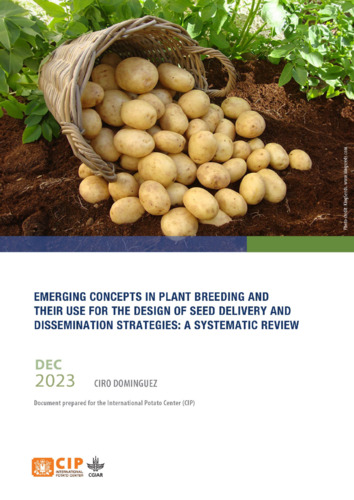The last five years have seen a burgeoning in the use of the terms business models, product profiles and market segments in the fields of plant breeding and seed systems. Since the mid-2010, within the Consultative Group on International Agricultural Research (CGIAR), these terms have also been used ubiquitously. But what do these terms actually mean? Where do they come from? Are they fully understood? How have they been used in the CGIAR? and How can they be further used to enhance delivery of new seed varieties and the impact of international plant breeding research? This study systematically reviews the literature about these terms to find out their roots and meaning, understand their use in plan breeding, and support the design of a seed delivery and dissemination strategy of new potato seed varieties released by the International Potato Centre (CIP) in Peru. The study follows the guidelines of PRESS (Peer Review of Electronic Search Strategies) and the PRISMA (Preferred Reporting Items for Systematic reviews and Meta-Analyses) 2020 statement, to review published studies containing these terms from both, the peer-reviewed and grey literature. Out of 1,733 studies found from six different bibliographic databases (Google Scholar, AgEcon, Web of Science, Scopus, Science Direct, Econbiz) (n=1,616) and specialized breeding platforms (n=117), a total of 416 were reviewed in full, and 163 were selected for inclusion in the literature review.
Our results show that the term business models been used since the 1990s in many research spheres, but notably in business, management, strategy and marketing. The concept has recently been drawn in plant breeding and seed systems, but the term in these fields is poorly understood, rarely defined and, with a few exceptions, it is rather used loosely and broadly. The concept has been used to interchangeably refer to seed delivery systems, it is sometimes confused with strategy and their components generally unknown or misunderstood. Product profiles and market segments are concepts also relatively new in the CGIAR. Together, product profiles and market segments are central to the design, development and delivery of new varieties based on demand-led breeding principles. While the use of product profiles in plant breeding is broad and, in general, it is fairly defined and well understood, market segments is less commonly defined, and research on this domain within plant breeding and the CGIAR is very small. Seed delivery and dissemination are terms deeply rooted in plant breeding and seed systems research; however, they are rarely defined, and most studies address these terms within the broader framework of seed systems and seed value chains. The literature recognizes three types of seed delivery systems: the formal, informal and intermediate. In each of these categories, a good range of delivery models have been described. Results show that seed delivery and dissemination strategies depend largely on the crop, crop type, country and predominating seed system. The choice of seed delivery systems also responds to government policies, donors’ support, country/region’s context, and institutions and projects involved in plant breeding and seed systems development. Seed delivery and dissemination strategies examined here can support the design of a seed delivery and dissemination strategy of new potato varieties delivered by CIP in Peru. However, the literature is largely concentrated in Africa and the experiences found for Latin America, specifically for Peru and in particular for seed potato, are very scarce.
Business models are an excellent tool for reflecting on i) what is the value proposition of new varieties released by CIP and how do they meet farmers’ needs, ii) what segments of customers can be targeted with these new varieties, iii) what are the key activities, key resources and key partners needed to produce and deliver them to target segments, iv) what delivery channels are the most appropriate for reaching these clients, and in general v) how CIP can differentiate from its competitors to create, deliver and capture value from plant breeding research. This can help breeding leads and R&D managers to design a business model for the production and delivery of new released potato seed varieties. The terms examined here help to define the value proposition, the customer segments and the channels components of this business model. Product profiles help to define the value proposition of a firm considering consumer preferences and needs; market segments help to answer the questions Who are our clients? What are our target market segments? Where are they? and What are their preferences?; seed delivery and dissemination help to answer the questions Through which channels can we reach our customer segments/clients? How are we reaching them now? How do we communicate with and deliver our value proposition to customers? Which channels work best for reaching out customers? and Which ones are most efficient to reach a larger number of clients? The introduction of these terms and demand-led-breeding principles into the CGIAR represent an important step towards the application of business models for crop improvement and seed delivery in public breeding research.
Emerging concepts in plant breeding and their use for the design of seed delivery and dissemination strategies: a systematic review
Citation: Dominguez, C. 2023. Emerging concepts in plant breeding and their use for the design of seed delivery and dissemination strategies: a systematic review. International Potato Center. 54 pp. DOI: 10.4160/cip.2023.12.005
2023-12-15
BREEDING, CROP AND SYSTEMS SCIENCES CSS, SEED SYSTEMS
report

